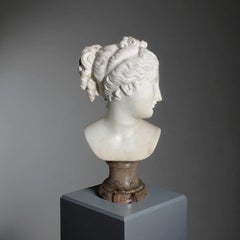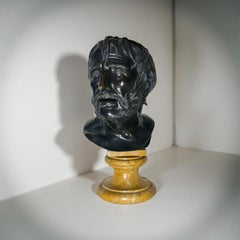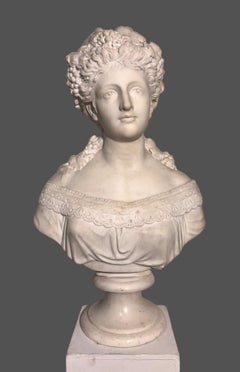Want more images or videos?
Request additional images or videos from the seller
1 of 9
UnknownTesta Neoclassica in Marmo dell' Afrodite di Cnidia circa 1830 Busto Scultura1830
1830
Price:$4,717.12
About the Item
- Creation Year:1830
- Dimensions:Height: 21.26 in (54 cm)Width: 15.36 in (39 cm)
- Medium:
- Movement & Style:
- Period:
- Condition:Articolo di antiquariato, segni di usura compatibili con l'epoca. Non ci sono rotture nè mancanze nè restauri.
- Gallery Location:Pistoia, IT
- Reference Number:1stDibs: LU2746214495182
About the Seller
4.8
Vetted Professional Seller
Every seller passes strict standards for authenticity and reliability
Established in 1997
1stDibs seller since 2024
17 sales on 1stDibs
Typical response time: 1 to 2 days
Authenticity Guarantee
In the unlikely event there’s an issue with an item’s authenticity, contact us within 1 year for a full refund. DetailsMoney-Back Guarantee
If your item is not as described, is damaged in transit, or does not arrive, contact us within 7 days for a full refund. Details24-Hour Cancellation
You have a 24-hour grace period in which to reconsider your purchase, with no questions asked.Vetted Professional Sellers
Our world-class sellers must adhere to strict standards for service and quality, maintaining the integrity of our listings.Price-Match Guarantee
If you find that a seller listed the same item for a lower price elsewhere, we’ll match it.Trusted Global Delivery
Our best-in-class carrier network provides specialized shipping options worldwide, including custom delivery.You May Also Like
Figurative Marble Sculpture, "Kindred"
By TONY GANGITANO
Located in San Diego, CA
This is a one of a kind Italian white Carerra marble sculpture by San Diego artist Tony Gangitano. Its dimensions are 10" x 25" x 10". It is on a black granite base. A certificate of authenticity will follow delivery.
This sculpture is a representation of Mary and Christ...
Category
2010s Italian School Figurative Sculptures
Materials
Granite, Marble
Musidora
Located in PARIS, FR
"Musidora"
by Odoardo FANTACCHIOTTI (1809-1877)
Sculpture made in white Carrara marble
signed on the side on the base " O. Fantacchiotti "
Italy
around 1862
height 110 cm
diameter ...
Category
1860s Italian School Nude Sculptures
Materials
Marble
Frine (Phryne), 19th Century Large Marble Sculpture of Nude Woman
Located in Beachwood, OH
Ercole Rosa (Italian, 1846 - 1893)
Frine (Phryne)
Marble
Signed 'E. Rosa, Studio O. Andreoni, Roma' on back
34.5 x 12 x 10 inches
80 lb.
Phryne was a 4th century BC famous Greek ...
Category
19th Century Italian School Figurative Sculptures
Materials
Marble
$35,000
H 34.5 in W 12 in D 10 in
Antique Italian Grand Tour Bronze Marble Bust Sculpture Dante Alighieri 1880
Located in Portland, OR
A good antique Italian Grand Tour Bronze and marble bust of Dante Alighieri, circa 1880.
The bronze is most likely Florentine and mod...
Category
Late 19th Century Italian School Figurative Sculptures
Materials
Marble, Bronze
$2,895
H 16 in W 19 in D 9 in
NYDIA, THE BLIND FLOWER GIRL OF POMPEII Marble Sculpture 1856-1870
Located in Soquel, CA
Randolph John Rogers (American, 1825 - 1892) Randolph Rogers' Nydia, the Blind Flower Girl of Pompeii debuted in 1856 to critical and public acclaim, solidifying Rogers’ position as a pre-eminent American sculptor and it remains one of the artist’s most celebrated works today. The subject of Nydia is drawn from Edward Bulwer-Lytton's The Last Days of Pompeii 1834. After touring the ruins of the ancient city in 1833, and inspired by the stories of blinding volcanic ash, he composed the tale of Nydia, a slave who led her master, Glaucus, to safety. Rogers depicts Nydia at the moment that she and Glaucus have become separated in their perilous journey through the rubble and Nydia seeks familiarity in the surrounding chaos, her distress evident in her pained expression. The grace of the sculpture is at odds with the turmoil portrayed; a toppled Corinthian capital lies at her feet and obstructs her next step, indicated by the tilt of her back foot and grip on her walking stick. Examples of this model can be found in major American collections, including The Metropolitan Museum of Art, the Art Institute of Chicago, the Detroit Institute of Arts, the Los Angeles County Museum of Art, and the Museum of Fine Arts, Boston.
Literature, Millard F Rogers, Jr. Randolph Rogers, American Sculptor in Rome. University of Massachusetts Press, 1971, American Figurative Sculpture in the Museum of Fine Arts Boston. Museum of Fine Arts, Boston, 1986. Joyce K Schiller. "Nydia, A Forgotten Icon of the Nineteenth Century." Bulletin of the Detroit Institute of Arts,
Born in Waterloo, New York, Randolph John Rogers became an expatriate* sculptor of idealized figures, portraits, and commemorative works in Neo-Classical* and Realist* styles. He worked in clay, plaster, marble and bronze, and lived both in Italy and the United States. He made 167 examples of Nydia in two sizes (varies depending on base height) 36" and 54'.
Rogers was raised in Ann Arbor, Michigan, and as a young man did woodcuts* for the local newspaper, The Michigan Argus, and also worked as a baker's assistant and a dry goods clerk. In 1847, he moved to New York City, where he hoped to find work as an engraver*, but failing to do so, worked in a dry goods store owned by John Steward...
Category
1850s Italian School Figurative Sculptures
Materials
Marble
$12,000 Sale Price
20% Off
H 36 in W 19 in D 20 in
Pair of Italian "Alabaster Stone Lions" after Antonio Canova; Mid 19th Century
Located in SANTA FE, NM
"Pair Recumbent Stone Lions"
after Antonio Canova (1757-1822)
Italian (possibly Florence)
Mid 19th Century
Alabaster, marble
6 x 9 x 4 inches
This is an exquisite pair of Italian alabaster lions on marble bases based on the monumental lions carved by Antonio Canova (1757-1822), the greatest Italian neoclassical sculptor. Canova sculpted the marble lions for the monumental tomb of Pope Clement XIII in St. Peter’s, Rome in 1792
Canova Lions refers to the pair of copies of lion sculptures by Antonio Canova. When Canova created the sculptures in 1792, he installed them on the tomb of Pope Clement XIII. The marble sculptures are some of the most prominent features in St. Peter's Basilica in Rome. Given the intricacies of creating the original Canova lions, some artists created molds and replicated them. A good example is the pair of lion sculptures...
Category
1850s Italian School Figurative Sculptures
Materials
Marble, Alabaster
$6,150
H 6 in W 9 in D 4 in
18th/19th C. Italian Alabaster Sculpture of Infant Hercules Wrestling a Snake
Located in Beachwood, OH
18th/19th Century Italian
Infant Hercules Wrestling a Snake
Alabaster
18 x 18 x 6 inches
40 lb.
In Greek mythology, the infant Hercules (Heracles) is famously depicted wrestling wit...
Category
Late 18th Century Italian School Figurative Sculptures
Materials
Alabaster
$4,800
H 18 in W 18 in D 6 in
"Violante Beatrice of Bavaria"
Located in Astoria, NY
Aristide Petrilli (Italian, 1868-1930) "Violante Beatrice of Bavaria" Alabaster Bust, late 19th century, the bust on an angular plinth, signed and titled. 17" H x 16" W x 7" D.
Category
Late 19th Century Italian School Figurative Sculptures
Materials
Alabaster
Female Figure Bust
Located in Astoria, NY
Italian School Female Figure Carved Alabaster Bust, late 19th century, the portrait with tied back hair and flowing dress tied at her breast, on a rockwork plinth, unsigned. 26" H x ...
Category
Late 19th Century Italian School Figurative Sculptures
Materials
Alabaster
Neapolitan Girl
By Emilio Fiaschi
Located in Astoria, NY
Emilio Fiaschi (Italian, 1858-1941) Neapolitan Girl Alabaster Bust, late 19th century, depicting a young girl hiding her face behind her hands, on a socle, signed "E Fiaschi" to back...
Category
Late 19th Century Italian School Figurative Sculptures
Materials
Alabaster
More From This Seller
View AllStatuary marble bust of Venus Italica second half of the 19th century Signed
Located in Pistoia, IT
Statuary white marble bust of Venus Italica signed Antonio Frilli - Florence, Italy, second half of the 19th century. Measurements H total cm 50 H bust cm 39 W cm 30 D cm 24 This l...
Category
19th Century Italian School Figurative Sculptures
Materials
Marble
Bronze bust of Seneca or Pseudo-Seneca Italy Naples late 18th-early 19th cent
Located in Pistoia, IT
Bronze bust with brown patina depicting the pseudo-Seneca, Italy, early 19th century.
The Pseudo-Seneca is a Roman bronze bust from the late 1st century B.C.. discovered in 1754 in ...
Category
Late 18th Century Italian School Figurative Sculptures
Materials
Marble, Bronze
Large White Marble Bust of Young Woman Signed
By Pio Fedi 1
Located in Pistoia, IT
Large white Carrara marble bust depicting a young woman with her hair adorned with leaves and bunches of grapes, signed "Fedi" on the back.
Originally from Viterbo but a Florentine ...
Category
1860s Italian School Figurative Sculptures
Materials
Marble
"La Danza", Grande scultura in Marmo bianco di Carrara XIX secolo
By Antonio Giovanni Lanzirotti
Located in Pistoia, IT
Antonio-Giovanni Lanzirotti, "La Danza", grande scultura in marmo bianco di Carrara, firmata AG Lanzirotti sulla base.
Antonio Giovanni Lanzirotti, nato a Palermo il 9 maggio 1839 e...
Category
1860s Italian School Figurative Sculptures
Materials
Marble
Venus Colca Neoclassical Marble Sculpture early 19th century
Located in Pistoia, IT
Crouching Venus, neoclassical Carrara marble sculpture, early 19th century.
An 18th-century English tourist to Florence wrote that of all the Venuses in the Uffizi, "only one grace...
Category
Early 19th Century Italian School Figurative Sculptures
Materials
Marble
Large Italian Neoclassical Marble Sculpture Allegory 18th century
Located in Pistoia, IT
Impressive neoclassical Carrara marble sculpture depicting the Allegory of Friendship and Loyalty, second half of the 18th century.
The sculpture depicts Friendship as a classical ...
Category
Late 18th Century Italian School Figurative Sculptures
Materials
Marble
Recently Viewed
View AllMore Ways To Browse
Bronze Nude Men
Bronze Rat
Bronze Sculpture Mane Katz
Bronze Signed F G
Bronze Sleeping Dog
Bruno Catalano
Buffalo Hunt Bronze
Capeo Flamenco
Caridad Del Cobre
Carl Anderson
Caroline Russell
Charles Bragg Sculpture
Chester Fields
Concetta Scaravaglione
Dali St John Of The Cross
Dali Tiles
Dan Dailey Glass
Dan Tanenbaum


